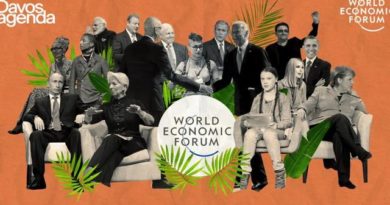Sutherland, Kalergi, Camus, Replacism and Technocracy
Guest Post by Iain Davis

In the UK, the so-called far-right‘s stance on immigration is said to be driven by “the Great Replacement conspiracy theory.”
According to the influential global think tank the Institute for Strategic Studies (ISD):
“The Great Replacement” theory was first coined by French writer Renaud Camus. Identitarian movements across Europe (including in Austria, the UK, Belgium, the Netherlands, France and Germany) have used the theory to recruit others to their cause, claiming their countries and national “identities” are under threat due to increasing immigrant populations.
It is true, in part, that Camus made this argument. Some elements of his philosophy are racist and do offer apparent rationales for religious bigotry. It is also true that Camus has been influential in the rise of the identitarian movement, which is perceived as “right-wing.” Identitarianism broadly stands in opposition to identitiy politics, considered progressive or “left-wing.”
While the identitarian movement generally opposes multiculturalism and defends ethno-culturalism, identity politics largely holds that states foist structural inequality of opportunity upon people based on their personal characteristics—such as their ethnicity, religion, gender, sexual orientation and disability, etc. Those who oppose multiculturalism perceive identity politics as a deliberate attempt to dilute or even eradicate their culture.
These sociopolitical and philosophical concepts have a massive “influence” on our polity, public discourse and society. The right vs left paradigm is thereby created and perpetuated through the constantly reported clash between the identitarian movement and identity politics.
Those who espouse the Great Replacement theory often cite the comments of Peter Sutherland (1946 – 2018) as evidence that there is a cohesive “plan” to replace European culture. Sutherland was “influential” in guiding the development of the EU and the World Trade Organisation (WTO). He was a banker, business man, lawyer and politician. Sutherland sat on the Bilderberg steering committee, he was chairman of Trilateral Commission European division and the European Round Table movement.

Peter Sutherland
Sutherland was part of what US Council on Foreign Relations (CFR) member David Rothkopf called the “Superclass.” In an on-stage discussion, held by the global think tank the Carnegie Endowment for International Peace (CEIP), Rothkopf generously defined members of the alleged Superclass as “people who influence the lives of millions across borders on a regular basis.”
Rothkopf’s opinion is aligned with a branch of political science called “elite theory.” It generally argues that oligarchs—those who use their immense wealth to buy social and political “influence”—are beneficial for, or necessary to, the function of a healthy society. Numerous contrarian economists, philosophers, political theorists and scientists have argued the elite theorists’ assertions are abject nonsense.
In 2012, speaking in the UK House of Lords to the the European Union Home Affairs Health and Education inquiry on Global Approach to Migration and Mobility, Sutherland was asked by Lord Sharkey to explain why he viewed inward migration necessary. Sutherland was of the opinion that declining and ageing populations in Europe needed demographic stimulus, even if just from an economic perspective.
Sutherland answered:
So demographics are a key element of the debate, and a key argument for the development of—I hesitate to use the word because people have attacked it—multicultural states. It is impossible to consider that the degree of homogeneity which is implied by the alternative argument can survive, because states have to become more open in terms of the people who inhabit them, as the United Kingdom has demonstrated.
Lord Judd noted that unemployment rates were particularly high across Europe—compared to the Americas and Oceania—among migrant populations. He Asked Sutherland why he thought that was the case and what the European Union proposed to do about it. Sutherland said:
[. . .] the United States or Australia and New Zealand are migrant societies and therefore accommodate more readily those from other backgrounds than we do ourselves, who still nurse a sense of our homogeneity and difference from others, which is precisely what the European Union, in my view, should be doing its best to undermine.
This prompted the BBC—among other legacy media outlets—to write “EU should ‘undermine national homogeneity’ says UN migration chief.” In an extremely atypical moment, the BBC added that Sutherland “has attended meetings of The Bilderberg Group, a top level international networking organisation often criticised for its alleged secrecy.”
Bilderberg meetings are not allegedly secretive. They use the Chatham House rule and are absolutely secretive.
While the BBC also explained Sutherland’s offered economic rationale, for the identitarian movement this was “proof” of the EU plan to eradicate their culture. The BBC’s very unusual mention of the Bilderberg group appeared to intentionally heighten these supposedly “far-right” fears.
The international “charity” Hope not hate (HNH) tells us:
The so-called “Kalergi plan” is an increasingly popular strain of the white genocide conspiracy theory, which alleges that there is a deliberate plan to undermine European white society by a campaign of mass immigration, integration and miscegenation conducted by sinister (and often Jewish) elites.
The purported foundation of this, even more “extreme” strain of the “Great Replacement” theory is the collection of essays published in 1925 by Count Richard von Coudenhove-Kalergi called Practical Idealism.

Richard von Coudenhove-Kalergi
Kalergi was the founder of the PanEuropa movement that eventually led to the creation of the European Union (EU). He was the inaugural recipient of the Charlemagne Prize—awarded to individuals who have contributed toward European Integration. This means they have promoted the process of industrial, economic, political, legal, social, and cultural integration of states within the EU. Ukrainian President Zelenskyy won the Charlemagne Prize in 2023.
Those who highlight the alleged “Great Replacement,” as the intentional dissolution of their culture through multiculturalism, cherry pick excerpts from Kalergi’s writing and ignore others. For example, the following quote is often referenced by the people labelled far-right:
The (European) man of the future will be of mixed race. Today’s races and classes will disappear owing to the disappearing of space, time, and prejudice. The Eurasian-Negroid race of the future, similar in its outward appearance to the Ancient Egyptians, will replace the diversity of peoples with a diversity of individuals.
Kalergi’ and Camus’ work has also been pounced upon by real far-right individuals and groups. To be honest, most of this owes more to their xenophobia and paranoia than it does to evidence or, indeed, any cogent analysis of either Kalergi or Camus.
If we think about it, the Great Replacement, as espoused by a tiny number of far-right voices, doesn’t make much sense. By all socio-economic and political measures, it is the the migrant populations in most countries that are the poorest and and least able to exercise either social or political power. If multiculturalism is the “planned” replacement of the indigenous ethno-culture, as the fringe “far-right” claims, it has been a miserable failure.
It seems pretty obvious that real social and political oppression is exerted through the class system. People from all ethnic groups and religious denominations suffer inequality of opportunity, first and foremost, by virtue of their economic status and class.
While UK governments consistently claim that social mobility is thriving in the UK, nearly every, more independent study suggests this is total claptrap:
The [UK] is associated with particular immobility among those on low and high incomes. The education system as a whole has failed to function as the great social leveller. [. . .] A recurring finding is that the workplace is as at least as important as education in determining mobility prospects. [. . .] Large gaps by background remain in the likelihood of climbing the income ladder, ending up in a higher social class, or securing a university degree. In terms of absolute social mobility, the evidence suggests that a former golden age of upward mobility has been replaced by a modern era of declining opportunities and more limited upward mobility.
Returning to our topic: think tanks, like the ISD, and NGO’ “charities,” like HNH, also ignore most of Kalergi’s and Camus’s ideas. If they reference them at all, they tend only to highlight the treatise that appear to be racist or bigoted and ignore the rest.
With regard to Kalergi, It is important to recognise that he was a man of his time and notably eccentric. Kalergi was mixed race and his vision of a European utopia was largely based upon his interpretation of the discredited pseudoscience of eugenics. Kalergi sought a Europe where “the best civil blood” would rise to power in a thriving meritocracy:
The noble man of the future will be neither feudal nor Jewish, neither bourgeois nor proletarian: he will be synthetic. Races and classes as we understand them today will disappear, individuals will remain. [. . .] Today, on the threshold of a new age, a random nobility takes the place of the former hereditary nobility; instead of aristocratic races, there will be noble individuals: people whose random blood composition elevates them to exemplary types. [. . .] Only the noblest men will be free to associate with the noblest women and vice versa — the inferior will have to content themselves with the inferior. [. . .] The natural hierarchy of human perfection will take the place of the artificial hierarchy, of feudalism and capitalism. [. . .] Here, in social eugenics, lies its highest historical mission, which it still has not realised today: to lead out of unjust inequality via equality to just inequality, over the ruins of all pseudo-aristocracy to genuine, new nobility.
Kalergi envisaged the demise of the class system and, conversely, the rise of a new technological elite who would command technology for the betterment of all:
Europe’s world mission is the liberation of mankind through technology. [. . .] Technology marks a similar turning point in human history like fire. In tens of thousands of years history will be divided into a pre-technological and a post-technological epoch. The European — who will by then have long been extinct — will be praised like a saviour by the future mankind as the father of the global technological transition. The possible effects of the technological age, at the beginning of which we are standing, cannot be overlooked. This age creates the material basis for all coming cultures, which will differ significantly from all previous ones due to their changed basis.
While the identitarian movement alleges the so-called “Kalergi Plan” is further evidence supporting its notion of ethno-cultural replacement, Kalergi—perhaps unknowingly—actually preempted the envisaged transition to a continental Technocracy.
Technocracy is the idea that Technates—instead of nation states—can be formed by splitting the “functions” of society into “special sequences” administered by “experts” or technocrats—instead of politicians—on a continental scale. The whole system can theoretically be centrally controlled through the management of a new monetary system based upon the distribution of the “energy certificates,” as required for each “function” of the Technate.
Technocracy became popular in the US during the Progressive Era (1901-1929). It was driven by the theory of using technology to improve efficiency, advocated by Frederick Winslow Taylor (Taylorism), and the resource allocation economic theories of economists like Thorstein Veblan (conspicuous consumption). Published less than a decade after Kalergi wrote Practical Idealism, the Technocracy Inc. Study Course formally introduced Technocracy to the world.
Instead of Kalergi’s “noblest men” forming a new “natural hierarchy of human perfection” Technocracy would supposedly see “natural peck-rights” awarded to those with the requisite technical skills and expertise. According to the technocrats, these chosen individuals would apparently emerge from “spontaneous natural priority.”
Like Kalergi, the technocrats thought a classless society was possible. It seems odd to believe societies dominated by a technocratic nobility could be called classless. But there are many bizarre contradictions found in Kalergi’s ideas and Technocracy. Nevertheless, both Kalergi and the technocrats recognised that “global technological transition” was key to fulfilment of their dreams.
More than three decades later, In 1970, Zbigniew Brzezinski, the co-founder alongside David Rockefeller of the Trilateral Commission—of which Peter Sutherland and Keir Starmer have been prominent members—wrote Between Two Ages: America’s Role In The Technetronic Era. Brzezinski and the Trilateralists accelerated the transition to Technocracy.
In 2022, the Trilateral Commission listed the current UK prime minister as a former member. Though why they felt the need to list Starmer, who is supposedly not a member, on their official membership list is confusing to say the least.
Technocracy appeals to the oligarch class—Rothkopf’s “Superclass”—because it is the most comprehensive system of social control ever devised. It utilises technology as a centrally managed tool for surveillance and behavioural control of the population. As noted by Brzezinski:
Such a society would be dominated by an elite whose claim to political power would rest on allegedly superior scientific know how. Unhindered by the restraints of traditional liberal values, this elite would not hesitate to achieve its political ends by using the latest modern techniques for influencing public behavior and keeping society under close surveillance and control.
More recently, the Editor in Chief of the Lancet medical journal, Richard Horton, observed how the state response to Covid-19 appeared to have sped up the transition to Technocracy:
It would be hard to deny that scientists have assumed a role in political decision making unparalleled in recent memory. [. . .] Technocracy is replacing democracy. Technocratic governments are crisis governments. And most western democracies are in crisis and will remain in crisis for several years to come.
The World Economic Forum says these crises—pandemics, war and the energy, cost-of-living and climate crises, etc.—are converging to form an alleged “polycrisis.” In turn, according to the UN—a WEF “partner”—the only possible solution to the so-called polycrisis is global Technocracy:
We do not know which extreme risk event will come next; it might be another pandemic, a new war, a high-consequence biological attack, a cyberattack on critical infrastructure, a nuclear event, a rapidly moving environmental disaster, or something completely different such as technological or scientific developments gone awry. [. . .] [T]o enable us to better anticipate and respond to such risks, it will be important for the United Nations to draw on a network of the best thinkers and data, externally and within the United Nations system, to present a Strategic Foresight and Global Risk Report to Member States every five years. [. . .] This would also be linked to corresponding governance arrangements for such risks, as appropriate, as well as the action needed to address them. [The UN proposes] to work with Member States to establish an Emergency Platform to respond to complex global crises. [. . .] It would be triggered automatically in crises of sufficient scale and magnitude, regardless of the type or nature of the crisis involved. Once activated, it would bring together leaders from Member States, the United Nations system, key country groupings, international financial institutions, regional bodies, civil society, the private sector, subject-specific industries or research bodies and other experts.
Polycrisis preparedness will be overseen by “a network” of technocrats who will devise the necessary “governance arrangements” and decree what “actions” government need to take. Centralised global control of government policy, in other words.
Via the diktat of the UN’s public-private global governance system, anything could be declared a global crisis. Once announced, the Emergency Platform will be “triggered automatically” and global technocratic control will be handed over to a global public-private partnership comprised of a few senior politicians, international NGO’s, global financial institutions, multinational corporations—including the banks—and “other experts.”
The allegation against Renaud Camus, made by think tanks like the ISD, are accurate only to a limited extent. The global think tanks omit Camus’ criticisms of, essentially, Technocracy. Though like Kalergi, Camus did not identify Technocracy by name.

Renaud Camus
Camus central thesis is better described as “replacism.” He criticised what he called “hyperdemocracy” which he characterised as the obsessive enforcement of “equality” that leads to the eradication of “all” culture. He suggested this produces a defenceless nation of people who, having been stripped of all cultural heritage, are unable to resist those who wish to make them replaceable with anyone or anything.
Camus doesn’t really attempt to explain why this “replacism” is happening. He does however point out, in the absence of any sense of cultural identity or belonging, people can be “turned into corporate managers or replaced by them.” He suggests that the effect of the blind commitment to egalitarianism, which he says typifies hyperdemocracy, leaves people incapable of differentiating between enemy or friend. This, he argued, renders populations little more than a malleable social mass.
Camus saw mass migration to Europe from the Global South as the cause of hyperdemocracy. He referred to this as “genocide by substitution.” But as we have just discussed, migrants generally possess less power than the indigenous population. If we consider his analysis, a critique we could offer is that mass migration is actually an effect, not a cause, of hyperdemocracy.
While Camus doesn’t address Technocracy directly, he does offer a robust criticism of Taylorism. He views Taylor’s elevation of “efficiency” above all other concerns as a core component of hyperdemocracy. Camus said that Taylor “is to replacism what Marx is to Marxism.”
Taylor described his concept of the more efficient management of society as “a complete mental revolution.” Camus argues this philosophical redrawing of society, in line with Taylorism, serves an elite managerial class that sees the individual as “a machine.”
As Mary Harrington notes in her fascinating exploration of Camus’ ideas:
Taylorism radically reframed (or rather, unframed) human workers as resources, whose nature is of interest only inasmuch as understanding it is conducive to the maximisation of productivity. That this was nonconsensual and involved a measure of covert violence was, Camus notes, well understood by Taylor’s contemporaries. [. . .] Camus points out, this represents less a causal relationship than the fact that “scientific management” emerged from the same overall paradigm, across both slavery and management theory. “Both reflect the same mechanistic vision of human work,” he argues, “and both rest on the premise that careful observation will enable the discovery of physical laws that will guarantee the maximum return.” Those physical laws guaranteeing maximum return require, in other words, enframing humans, and thus by extension minimising or excluding what can’t be monetised. [. . .] This is summed by Taylor’s bold assertion, quoted by Camus, that “In the past, man has been first; in the future, the system must be first”. This means, in effect, rendering workers “as disposable as possible, as dispensable, as replaceable – in sum, as little human.”
Renaud Camus viewed the mechanisms of “replacism,” binding humanity to the status of a replaceable resource to be used by the system, as a form of sociopolitical violence he called “nocence.” Camus observed that “nocence” is the enforcement of “replacism,” effectively dehumanising us all:
A spectre is haunting Europe and the world. It is replacism, the tendency to replace everything with its normalized, standardized, interchangeable double: the original by its copy, the authentic by its imitation, the true by the false, mothers by surrogate mothers, culture by leisure activities and entertainment, knowledge by diplomas, the countryside and city by the universal suburb, the native by the non-native, Europe by Africa, men by women, men and women by robots, peoples by other peoples, humanity by a savage, undifferentiated, standardized, infinitely interchangeable posthumanity.
The real “far-right,” though largely ineffective and mostly irrelevant, sees what it wants to see in the words of Sutherland, the writings of Kalergi and the philosophy of Camus. It uses its misinterpretation of these ideas to justify its racism and religious bigotry.
Equally, the advocates of identity-politics—who are socially and politically dominant—focus exclusively on the “Great replacement conspiracy theory.” They completely ignore the more rational concerns of the identitarian movement described by Camus and others. Thus, labelling any criticism of their own ethos “far-right” and stumbling blindly towards Technocracy.
Similarly, global think tanks, like the ISD and the CEIP, who undoubtedly understand that Kalergi foresaw and supported the transition to Technocracy and that Camus warned against it, also mischaracterize such ideas as nothing more than a “far-right conspiracy theory.” The oligarchs that wish to see Technocracy established can capitalise on the ramblings of the real far-right minority by framing all dissent against the emerging Technate as “extremism.”
For the global public-private partnership, coalescing around the global governance systems of the UN, that seeks to use “nocence” to facilitate the “replacism” necessary for Technocracy, the racist bigotry of the genuine “far-right” is a gift. It is certainly in their interests to promote the so-called far-right threat.
For example, in 1993 CFR member Samual P. Huntington published his article in the CFR’s in-house magazine Foreign Affairs titled The Clash of Civilisations. Huntington claimed that Islam presented an existential threat to Western civilisation and argued that “The great divisions among humankind and the dominating source of conflict will be cultural.”
Clearly, this is an argument supported by the “far-right.” It is precisely what people like Tommy Robinson claim to be the most pressing social problem of our time.
Writing for the Trilateral Commission in 1975, Huntington co-wrote The Crisis of Democracy: On the Governability of Democracies. In it, the Trilateralists argued that power is diminished by what they called an “excess of democracy” and that “the prestige and authority of central government institutions” must be restored. These sought-after sociopolitical conditions are inherent to Technocracy.
Unlike Camus’ theories or Kalergi’s ideas, Huntington’s opinions are not attacked as “far-right.” By casting any and all opposition to nocence-based policy initiatives as “far-right extremism,” the so-called “Superclass” creates a fake moral argument that can be used to censor, marginalise, and cancel all criticisms of the global Technocracy they are installing.
Perhaps more crucially, by perpetuating the left-right paradigm, pitting the identitarian movement against the advocates of identity politics, populations can be mired in pointless debates. This irrelevant distraction, embodied by the vacuum of party politics, leaves the global public-private partnership free to push ahead with the rollout of Technocracy while the people engage in counter-productive arguments and continually fail to recognise their real enemy: the oligarchs.
Just as Renaud Camus, among others, predicted.





